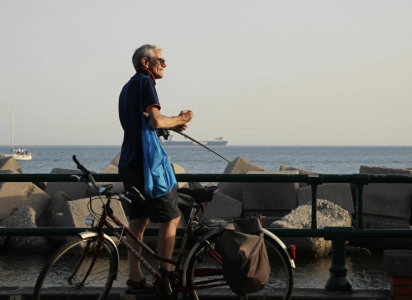What’s changing for cyclists in July? A new rule could mean fewer stops—and safer rides
By
Veronica E.
- Replies 0
If you’ve ever pedaled up to a stop sign only to lose your momentum at a complete halt, you’re not alone.
For cyclists, especially older riders, these stop-and-go moments can feel more exhausting than helpful—and sometimes even less safe.
As of July 1, New Mexico is joining a growing list of states easing the rules for people on bikes.
The goal? To improve safety and make intersections easier to navigate for cyclists of all ages.
Here’s what’s changing, why it matters, and how it might affect the way you share the road.

Cyclists can now treat stop signs as yield signs
New Mexico’s new law adopts what’s commonly called the “Idaho stop.”
Originally introduced in Idaho in 1982, this rule allows cyclists to treat stop signs as yield signs and red lights as stop signs.
In other words, if you’re riding a bicycle and the intersection is clear, you can roll through a stop sign without coming to a complete stop.
At red lights, cyclists may come to a stop, check for traffic, and proceed through the light if it’s safe to do so.
This small adjustment means cyclists can keep moving—while still being expected to yield to pedestrians and cross traffic.
It also eliminates the risk of being fined $25 for rolling through a stop sign on a bike.
Also read: Seniors: How will the new July driving law affect your license renewal?
A safety measure backed by data
At first glance, the new rule might seem like it encourages reckless behavior.
But in practice, the change has actually made roads safer.
After Idaho implemented its stop-as-yield law, the state saw a 14.5% decrease in cyclist injuries in just one year.
Cycling advocates say this is because the law gives riders a head start at intersections—allowing them to stay more visible and avoid dangerous “right hook” situations, where a car turns right into a bike crossing its path.
Eric Biedermann, board member of BikeABQ, noted, “There are a number of ways in which being able to proceed through an intersection with a head start before the cars move really enhances cyclist safety.”
Also read: Could your CVS be closing? New Arkansas Law puts all 23 stores at risk.
New Mexico’s cyclist crash stats are sobering
Between 2019 and 2023, New Mexico recorded 1,457 reported bicycle crashes.
Of those, 39 cyclists died and 115 suffered serious injuries. Another 694 were injured but able to walk away.
While numbers like these may seem small, they underscore the risks cyclists face on public roads every day—especially in intersections.
Lynn Pickard, a retired judge and member of Santa Fe Seniors on Bikes, believes the law is a step in the right direction: “Anything that helps cyclists get in and out of intersections quickly—while still using good judgment—can make a real difference.”
Also read: The $64 mistake hiding in plain sight—this new law could cost you
The rules still apply to drivers
If you’re behind the wheel, you might be wondering what this means for you.
The answer: not much has changed. The “Idaho stop” rule applies to cyclists only.
Drivers must still come to a complete stop at red lights and stop signs. Running a red light in New Mexico will still cost you $25.
The law doesn’t give cyclists a free pass—it simply gives them a bit more flexibility, as long as they act safely and responsibly.
Also read: New law cracks down on hidden rental fees—here’s what renters need to know
Other traffic law changes across the country
New Mexico isn’t the only state updating its road rules.
Across the US, new laws are going into effect in 2025 to improve road safety for all users:
Here’s how to stay safe and informed under the new rules:
Cycling is a favorite pastime for many older adults—whether for exercise, errands, or enjoyment. But staying active also means staying safe.
These new traffic laws recognize that cyclists have different needs than drivers.
By letting cyclists move more efficiently through intersections, states hope to encourage more people—of all ages—to bike with confidence.
Read next: Avoid a $250 hit to your wallet! Are you towing illegally under this new parking law?

Are you a cyclist who’s excited about this change? A driver with questions or concerns? Or maybe you’ve experienced the “Idaho stop” in another state? We want to hear your stories.
Do you think these changes will improve safety—or create confusion? Share your thoughts in the comments, and let’s talk about how we can make the roads safer and more accessible for everyone.
For cyclists, especially older riders, these stop-and-go moments can feel more exhausting than helpful—and sometimes even less safe.
As of July 1, New Mexico is joining a growing list of states easing the rules for people on bikes.
The goal? To improve safety and make intersections easier to navigate for cyclists of all ages.
Here’s what’s changing, why it matters, and how it might affect the way you share the road.

Cyclists across the US are navigating new road rules designed to improve safety and flow at intersections. Image Source: Pexels / Michelle Toma.
Cyclists can now treat stop signs as yield signs
New Mexico’s new law adopts what’s commonly called the “Idaho stop.”
Originally introduced in Idaho in 1982, this rule allows cyclists to treat stop signs as yield signs and red lights as stop signs.
In other words, if you’re riding a bicycle and the intersection is clear, you can roll through a stop sign without coming to a complete stop.
At red lights, cyclists may come to a stop, check for traffic, and proceed through the light if it’s safe to do so.
This small adjustment means cyclists can keep moving—while still being expected to yield to pedestrians and cross traffic.
It also eliminates the risk of being fined $25 for rolling through a stop sign on a bike.
Also read: Seniors: How will the new July driving law affect your license renewal?
A safety measure backed by data
At first glance, the new rule might seem like it encourages reckless behavior.
But in practice, the change has actually made roads safer.
After Idaho implemented its stop-as-yield law, the state saw a 14.5% decrease in cyclist injuries in just one year.
Cycling advocates say this is because the law gives riders a head start at intersections—allowing them to stay more visible and avoid dangerous “right hook” situations, where a car turns right into a bike crossing its path.
Eric Biedermann, board member of BikeABQ, noted, “There are a number of ways in which being able to proceed through an intersection with a head start before the cars move really enhances cyclist safety.”
Also read: Could your CVS be closing? New Arkansas Law puts all 23 stores at risk.
New Mexico’s cyclist crash stats are sobering
Between 2019 and 2023, New Mexico recorded 1,457 reported bicycle crashes.
Of those, 39 cyclists died and 115 suffered serious injuries. Another 694 were injured but able to walk away.
While numbers like these may seem small, they underscore the risks cyclists face on public roads every day—especially in intersections.
Lynn Pickard, a retired judge and member of Santa Fe Seniors on Bikes, believes the law is a step in the right direction: “Anything that helps cyclists get in and out of intersections quickly—while still using good judgment—can make a real difference.”
Also read: The $64 mistake hiding in plain sight—this new law could cost you
The rules still apply to drivers
If you’re behind the wheel, you might be wondering what this means for you.
The answer: not much has changed. The “Idaho stop” rule applies to cyclists only.
Drivers must still come to a complete stop at red lights and stop signs. Running a red light in New Mexico will still cost you $25.
The law doesn’t give cyclists a free pass—it simply gives them a bit more flexibility, as long as they act safely and responsibly.
Also read: New law cracks down on hidden rental fees—here’s what renters need to know
Other traffic law changes across the country
New Mexico isn’t the only state updating its road rules.
Across the US, new laws are going into effect in 2025 to improve road safety for all users:
- California: No parking within 20 feet of crosswalks (a “daylighting” law), and higher penalties for street racing.
- Colorado: New car seat regulations, stricter rules on express lanes, and bans on handheld phone use.
- Illinois: Digital driver’s licenses and new right-of-way rules for emergency vehicles.
- Kentucky: Vision tests required for driver’s license renewals.
- Oregon: Tougher school bus safety laws.
- Texas: Eliminated vehicle safety inspections.
- Rhode Island: A $500 fine and possible license suspension for wrong-way driving on highways or ramps.
Here’s how to stay safe and informed under the new rules:
- Cyclists: Yield to pedestrians, watch for oncoming traffic, and proceed only when it’s safe.
- Drivers: Stay alert for cyclists, especially at intersections. They may move through before you expect it.
- Everyone: Review your state’s updated traffic laws. Knowing the rules helps keep everyone safer on the road.
Cycling is a favorite pastime for many older adults—whether for exercise, errands, or enjoyment. But staying active also means staying safe.
These new traffic laws recognize that cyclists have different needs than drivers.
By letting cyclists move more efficiently through intersections, states hope to encourage more people—of all ages—to bike with confidence.
Read next: Avoid a $250 hit to your wallet! Are you towing illegally under this new parking law?
Key Takeaways
- New Mexico now allows cyclists to roll through stop signs and red lights (when safe) under a new law aimed at improving intersection safety.
- The rule—known as the “Idaho stop”—has been shown to reduce bike injuries, with Idaho seeing a 14.5% drop after its adoption.
- From 2019 to 2023, New Mexico had 1,457 bicycle crashes, including 39 fatalities and 115 serious injuries, emphasizing the need for cyclist safety.
- Other states have also introduced new traffic laws in 2025, targeting issues like distracted driving, school zone safety, and street racing.
Are you a cyclist who’s excited about this change? A driver with questions or concerns? Or maybe you’ve experienced the “Idaho stop” in another state? We want to hear your stories.
Do you think these changes will improve safety—or create confusion? Share your thoughts in the comments, and let’s talk about how we can make the roads safer and more accessible for everyone.






